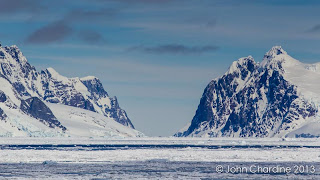The last two days we spent at sea, most of the time in
the Drake Passage. We had a little bit of stronger wind and many of our Chinese
guests could not really handle this. They preferred to stay in the cabins and
we got the feeling that we had suddenly lost quiet a number of passengers in
Antarctica. But on the Captains Farewell they showed up all again. Some still a
little bit pale in the face but happy to be in the calmer waters of the
entrance of the Beagle Channel.
We thought, that this is the right time to let our
wonderful trainee, Niri, from Norway let write again about his experiences
until now.
Hallo blogger!
It’s me again, Niri the trainee.
I have now been
with the FRAM for 2 trips. The first tour has been a trip with passengers from
nearly all over the world to the Falkland Islands (Islas Malvinas), South
Georgia and the Antarctic peninsula. My second trip has been a full Chinese charter
to the Antarctic Peninsula.
Tomorrow my third and last trip will start; again with
passengers from many different nations and again to the Falkland Islands (Islas
Malvinas), South Georgia and the Antarctic peninsula. I am looking forward to
it as I want to see how different the landscape looks like later in the season
and what my new friends, the penguins and all the other birds are doing now, in
December.
I took some time to understand how far from home I
really am, but seeing the flora and fauna in Antarctica I understood that I’m
on the other side of the planet!
The animals that live in and around the south icy sea
are really interesting creatures! It’s very nice to work with a team that
consists of people with different specialties! If I have a question about
history, biology, geology, organizing or anything else, someone in the team can
answer.
Everything runs on tracks in the team. It’s clear to me
that they have a lot of experience doing this kind of thing.
The daily life of the ship can be calm, like on a sea
day. But if we have kayaking, camping, cruising and ordinary landings all in
the same day, things can get busy! But I like it, you get time to relax but you
don’t get too lazy. But of course I have not to lecture so that I have a little
bit more time, especially on sea days, than my lecturer colleagues.
Here you can see my team and me in "action".
 |
| Photo John Chardine |
 |
| Photo John Chardine |
 |
| Photo Ina Schau Johansen |
 |
| Photo Marsel van Oosten |
I know I’m going to enjoy the next trip, hiking, polar
circle boat rides, maybe camping, more seals and a lot of fun!


















































